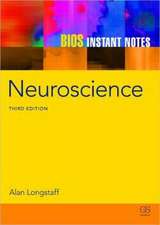New Aspects of Axonal Structure and Function
Editat de Dirk Feldmeyer, Joachim Lübkeen Limba Engleză Paperback – 4 sep 2014
| Toate formatele și edițiile | Preț | Express |
|---|---|---|
| Paperback (1) | 1214.90 lei 43-57 zile | |
| Springer Us – 4 sep 2014 | 1214.90 lei 43-57 zile | |
| Hardback (1) | 1224.36 lei 43-57 zile | |
| Springer Us – 30 aug 2010 | 1224.36 lei 43-57 zile |
Preț: 1214.90 lei
Preț vechi: 1481.59 lei
-18% Nou
Puncte Express: 1822
Preț estimativ în valută:
232.49€ • 241.26$ • 194.33£
232.49€ • 241.26$ • 194.33£
Carte tipărită la comandă
Livrare economică 17-31 martie
Preluare comenzi: 021 569.72.76
Specificații
ISBN-13: 9781489982032
ISBN-10: 1489982035
Pagini: 256
Ilustrații: XVII, 237 p.
Dimensiuni: 155 x 235 x 13 mm
Greutate: 0.36 kg
Ediția:2010
Editura: Springer Us
Colecția Springer
Locul publicării:New York, NY, United States
ISBN-10: 1489982035
Pagini: 256
Ilustrații: XVII, 237 p.
Dimensiuni: 155 x 235 x 13 mm
Greutate: 0.36 kg
Ediția:2010
Editura: Springer Us
Colecția Springer
Locul publicării:New York, NY, United States
Public țintă
ResearchDescriere
Axons are neuronal output elements and are responsible for the transfer and processing of signals from one neuron to another, even over very large distances. For a given neuronal cell type, axons are unique and display very heterogeneous patterns with respect to shape, length and target structure. Axons are the usually long process of a nerve fiber that generally conducts impulses away from the body of the nerve cell. This book is intended to summarize recent findings covering morphological, physiological, developmental, computational and pathophysiological aspects of axons. It attempts to cover new findings concerning axonal structure and functions together with their implications for signal transduction, processes implicated in the formation of axonal arbors and the transport of subcellular elements to their targets, and finally how a dysfunction in one or several of these steps could lead to axonal degeneration and ultimately to neurodegenerative diseases.
Cuprins
PrefaceForewordPart I: Axons in development1. Molecular Aspects of Commissural Axon GuidanceVera Niederkofler and Esther T. Stoeckli2. Subplate and the formation of the earliest cerebral cortical circuitsZoltán Molnár, Wei Zhi Wang, Maria Carmen Piñon, Shinichi Kondo, Franziska Oeschger and Anna Hoerder-SaubedissenPart II: Axonal function3. Sodium signals and their significance for axonal functionTony Kelly and Christine R. Rose4. New insights in information processing in the axonDominique Debanne and Sami Boudkkazi5. Electrical coupling of axonsGunnar Birke, Dietmar Schmitz and Andreas Draguhn6. To myelinate or not to myelinate? Quan Wen and Dmitri B. ChklovskiiPart III: Axons and neuronal circuits7. An axonal perspective on cortical circuitsTom Binzegger, Rodney J. Douglas, and Kevan A. C. Martin 8. Axonal projections as predictors of neuronal connectivityMoritz Helmstaedter and Dirk Feldmeyer9. The axon of excitatory neurons in the neocortex: Projection pat-terns and target specificityJoachim H.R. Lübke and Dirk FeldmeyerPart IV: Axons and degeneration/regeneration10. Axon degeneration: Mechanisms and consequencesLucy J. Broom and V. Hugh Perry11. Regeneration after CNS lesion: Help from the immune system?Sven Hendrix and Robert Nitsch
Textul de pe ultima copertă
For any neuronal cell type, axons are unique neuronal output elements that display very heterogeneous patterns with respect to shape, length, and target structure. New Aspects of Axonal Structure and Function summarizes recent findings covering morphological, physiological, developmental, computational, and pathophysiological aspects of axons. The book covers new findings concerning axonal structure and functions together with their implications for signal transduction in the nervous system. The book also describes the processes implicated in the formation of axonal arbors and the transport of subcellular elements to their targets. Finally, New Aspects of Axonal Structure and Function also shows how a dysfunction in one or several of these steps could lead to axonal degeneration and ultimately to neurodegenerative diseases.
New Aspects of Axonal Structure and Function can be used as a reference for neuroscientists, neurophysiologists, neuroanatomists, computational neuroscientists, cellular neuroscientists, as well as Ph.D. students in various neuroscience programs.
About the Editors:
Dirk Feldmeyer was born in Dortmund, Germany and studied Biology and German literature and linguistics at the Ruhr-University in Bochum where he received his Ph.D. in 1987. In 2001, he obtained a postdoctoral fellowship in the Dept. of Pharmacology, University College London. He joined the Dept. of Cell Physiology, at the Max Planck Institute of Medical Research in 1995 and in 2004 became independent group leader at the Institute of Medicine, Research Centre Jülich. In 2008 he was appointed to a professorship on "Function of Cortical Microcircuits" in the Dept. of Psychiatry and Psychotherapy, RWTH Aachen University, Germany. His research interests are neuronal microcircuits in the neocortex, their development and modulation.
Joachim H.R. Lübke was born on November 4, 1956 in Gelsenkirchen and trained as a biological-technical assistant. He studied biology at the Georg-August University of Göttingen and did his Ph.D. at the Max Planck Institute for Biophysical Chemistry (Head: Prof. Otto-Detlev Creutzfeld). From 1991-1993 he was a postdoctoral fellow of the Royal Society at the Dept. of Human Anatomy (Head: Prof. Ray Guillery) of the University of Oxford. From there he moved as a "von Helmholtz" fellow of the German ministry of Eduction and Research to the Institute of Anatomy at the Albert-Ludwigs University Freiburg (Head: Prof. Michael Frotscher). In 1997 he received the Wolfgang-Bargmann prize of the German Anatomical Society. He did his "habilitation" in anatomy and neuroanatomy in 1999 and was appointed assistant professor at the Department of Anatomy of the University of Freiburg in 2000. In 2003 he was appointed to group leader position at the Institute of Medicine, Research Centre Jülich. He was appointed professor at the Faculty of Medicine of the Heinrich-Heine-University Düsseldorf. In 2008 he was also appointed to a Professorship on "Structure of Cortical Functional Units" at the Dept. of Psychiatry and Psychotherapy, RWTH Aachen University, Germany.
New Aspects of Axonal Structure and Function can be used as a reference for neuroscientists, neurophysiologists, neuroanatomists, computational neuroscientists, cellular neuroscientists, as well as Ph.D. students in various neuroscience programs.
About the Editors:
Dirk Feldmeyer was born in Dortmund, Germany and studied Biology and German literature and linguistics at the Ruhr-University in Bochum where he received his Ph.D. in 1987. In 2001, he obtained a postdoctoral fellowship in the Dept. of Pharmacology, University College London. He joined the Dept. of Cell Physiology, at the Max Planck Institute of Medical Research in 1995 and in 2004 became independent group leader at the Institute of Medicine, Research Centre Jülich. In 2008 he was appointed to a professorship on "Function of Cortical Microcircuits" in the Dept. of Psychiatry and Psychotherapy, RWTH Aachen University, Germany. His research interests are neuronal microcircuits in the neocortex, their development and modulation.
Joachim H.R. Lübke was born on November 4, 1956 in Gelsenkirchen and trained as a biological-technical assistant. He studied biology at the Georg-August University of Göttingen and did his Ph.D. at the Max Planck Institute for Biophysical Chemistry (Head: Prof. Otto-Detlev Creutzfeld). From 1991-1993 he was a postdoctoral fellow of the Royal Society at the Dept. of Human Anatomy (Head: Prof. Ray Guillery) of the University of Oxford. From there he moved as a "von Helmholtz" fellow of the German ministry of Eduction and Research to the Institute of Anatomy at the Albert-Ludwigs University Freiburg (Head: Prof. Michael Frotscher). In 1997 he received the Wolfgang-Bargmann prize of the German Anatomical Society. He did his "habilitation" in anatomy and neuroanatomy in 1999 and was appointed assistant professor at the Department of Anatomy of the University of Freiburg in 2000. In 2003 he was appointed to group leader position at the Institute of Medicine, Research Centre Jülich. He was appointed professor at the Faculty of Medicine of the Heinrich-Heine-University Düsseldorf. In 2008 he was also appointed to a Professorship on "Structure of Cortical Functional Units" at the Dept. of Psychiatry and Psychotherapy, RWTH Aachen University, Germany.
Caracteristici
Summarizes recent findings covering morphological, physiological, developmental, computational and pathophysiological aspects of axons.
Covers new findings concerning axonal structure and functions together with their implications for signal transduction in the nervous system.
Describes the processes implicated in the formation of axonal arbors and the transport of subcellular elements to their targets.
Includes supplementary material: sn.pub/extras
Covers new findings concerning axonal structure and functions together with their implications for signal transduction in the nervous system.
Describes the processes implicated in the formation of axonal arbors and the transport of subcellular elements to their targets.
Includes supplementary material: sn.pub/extras













